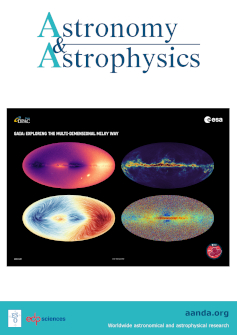The efficiency of mixed modes for angular momentum transport
IF 5.4
2区 物理与天体物理
Q1 ASTRONOMY & ASTROPHYSICS
引用次数: 0
Abstract
Context. Core rotation rates of red giant stars inferred from asteroseismic observations are substantially lower than ones predicted by current stellar models. This indicates the lack of an efficient angular momentum transport mechanism in radiative interiors. Mixed pressure-gravity modes are a promising candidate to extract angular momentum from the core of red giants.Aims. We focus on determining the effect of mixed modes on the rotation rates of stars evolving along the red giant branch (RGB).Methods. We developed a post-processing code that computes the angular momentum transport by meridional currents, shear-induced turbulence, and mixed modes. Rotation rates were computed for models along the RGB with different stellar masses and different initial rotation profiles.Results. We find that the mixed modes can explain some of the spin-down observed in red giant stars; however, the values of non-radial mode amplitudes strongly affect the efficiency of this mechanism. Rotation rates from models neglecting radiative damping on the mixed mode amplitudes overlap with observations and produce a localised spin-down around the hydrogen-burning shell, whereas the inclusion of radiative damping strongly suppresses and delays this spin-down. We also show that including an additional viscosity term with values in the range of 103−104 cm2 s−1 redistributes the localised spin-down due to the mixed modes, enhancing their efficiency.Conclusions. Our results reveal that the mixed mode amplitudes need to be constrained to precisely quantify the spin-down of red giant cores. Nevertheless, the mixed mode mechanism by itself cannot explain the full spread in observed core rotation rates along the RGB. This will only be possible with an additional mechanism for angular momentum transport.角动量输运的混合模式效率
上下文。从星震观测中推断出的红巨星的核心旋转速率比目前恒星模型预测的要低得多。这表明在辐射内部缺乏有效的角动量传递机制。混合压力-重力模式是一种很有希望从红巨星的核心提取角动量的候选模式。我们的重点是确定混合模式对沿红巨星分支(RGB)演化的恒星旋转速率的影响。我们开发了一个后处理代码来计算经向流、剪切引起的湍流和混合模式下的角动量传输。计算了具有不同恒星质量和不同初始旋转轮廓的模型沿RGB的旋转速率。我们发现混合模式可以解释在红巨星中观测到的一些自旋下降;然而,非径向模态振幅的取值强烈影响该机构的效率。忽略混合模态振幅上辐射阻尼的模型的旋转速率与观测值重叠,并在氢燃烧壳周围产生局部自旋下降,而包含辐射阻尼则强烈抑制和延迟这种自旋下降。我们还表明,在103 - 104 cm2 s - 1范围内加入一个附加的粘度项,重新分配了由于混合模式引起的局部自旋下降,提高了它们的效率。我们的结果表明,混合模振幅需要被限制,以精确地量化红巨星核心的自旋下降。然而,混合模式机制本身并不能解释观测到的沿RGB的核心旋转速率的完全扩散。这只有在角动量输运的附加机制下才有可能。
本文章由计算机程序翻译,如有差异,请以英文原文为准。
求助全文
约1分钟内获得全文
求助全文
来源期刊

Astronomy & Astrophysics
地学天文-天文与天体物理
CiteScore
10.20
自引率
27.70%
发文量
2105
审稿时长
1-2 weeks
期刊介绍:
Astronomy & Astrophysics is an international Journal that publishes papers on all aspects of astronomy and astrophysics (theoretical, observational, and instrumental) independently of the techniques used to obtain the results.
 求助内容:
求助内容: 应助结果提醒方式:
应助结果提醒方式:


